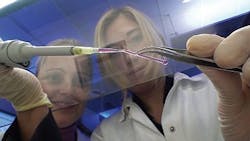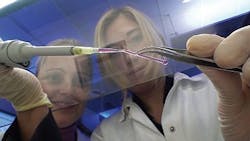3-D printing technique yields artificial blood vessels for tissue engineering
Researchers at the Fraunhofer Institute (Munich, Germany) have combined 3-D printing technology established in rapid prototyping with multiphoton polymerization to create biocompatible, artificial blood vessels for tissue engineering.
When combined with multiphoton polymerization, a 3-D inkjet printer can generate 3-D solids quickly and precisely. Brief, intensive laser pulses impact the material and stimulate the molecules in a tiny focus point to crosslink them. The material then becomes an elastic solid due to the properties of the precursor molecules that have been adjusted. In this way, highly precise, elastic artery structures are built according to a 3-D building plan. Dr. Günter Tovar, project manager at the Fraunhofer Institute for Interfacial Engineering and Biotechnology (IGB; Stuttgart, Germany), notes that while the individual techniques are already functioning and presently working in the test phase, the prototype for the combined system is being built.
But the right material is crucial to manufacture 3-D elastic solids, so the researchers came up with special inks to allow the later blood vessels to be flexible and elastic enough to interact with the natural tissue. Therefore, the synthetic tubes are biofunctionalized so that living body cells can dock onto them.
To accomplish this, the artificial blood vessels integrate modified biomolecules such as heparin and anchor peptides into the inside walls. That way, endothelial cells that form the innermost wall layer of each vessel in the body can attach themselves in the tube systems. Tovar points out that the lining is important to make sure that the components of the blood do not stick, but are transported onwards. The vessel can only work in the same fashion as its natural model to direct nutrients to their destination if an entire layer of living cells can be established, he says.
Looking ahead, 3-D printed blood vessels could serve as organic bypasses for people with clogged arteries or as replacement capillaries for smokers.
-----
Follow us on Twitter, 'like' us on Facebook, and join our group on LinkedIn
Follow OptoIQ on your iPhone; download the free app here.
Subscribe now to BioOptics World magazine; it's free!

